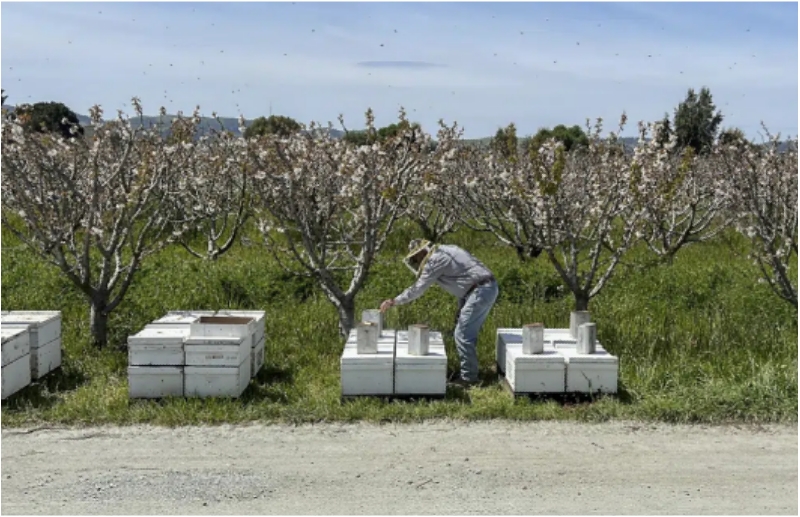California’s prolonged, wet winter has taken a toll on the state’s beekeepers. Many beekeepers in the Central Valley community of Los Banos have had to spend twice as much money on a sugary syrup to feed their honeybees and keep them alive. The delay in the bees’ emergence due to chilly temperatures, wind, and rain has left them without sufficient nectar and pollen for nourishment.
Most commercial beekeepers send their bees to California early in the year to help pollinate its $5 billion-a-year almond crop, then move them elsewhere to pollinate commodities ranging from avocados to cherries or to the Midwest to produce honey. The state was battered this winter by at least a dozen atmospheric rivers and powerful storms fueled by arctic air that produced blizzard conditions in mountainous areas.
The wintry weather flooded homes, triggered power outages and brought much-needed rain to drought-parched agriculture, though in some cases, more water than the crops could withstand. It also took a toll on bees, who were slow to emerge from their hives during the cold front and weeks of showers.
Almond growers say it’s too soon to know if the delay in the bees’ emergence will hurt the state’s nut crop, which accounts for about 80% of the world’s almonds, according to the Almond Board of California. With a slight reduction in almond acreage following three years of drought and the intense winter, it’s possible there will be fewer nuts this year than last, which was a boom year for the crop.
Almond trees depend on bees for cross-pollination, and bees in turn feed on almond pollen, which helps sustain the hives throughout the bloom. While many people keep bees as a hobby, commercial beekeepers may have hundreds of hives and relocate their bees to pollinate various crops in distinct seasons.
Bryan Ashurst, who sends his bees north from California’s Imperial Valley to pollinate almond trees, said some hives were washed away by flooding. He said he sent six workers to try to feed his bees during the cold snap since they weren’t out flying — something he hasn’t done in at least two decades and that cost at least $45,000.
Dan Winter, president of the American Beekeeping Federation, trucked his bees from Florida in late January to pollinate California’s almond orchards, which took longer than usual due to the weather. That delayed their return, so he said he now must hurry to get the hives ready to head to New York for apple tree pollination in less than a month.
The wet winter is not all bad news for beekeepers, though. The rain is expected to bring a burst of spring wildflowers, which could provide ample forage for bees and potentially translate into a good year for honey.
Gene Brandi said he’ll take his hives to coastal areas this spring so the bees can forage on a native plant to make sage honey, a premium product that he can only make every few years when there’s ample rain.
“It is the finest honey we can make,” he said, adding that the last sage honey he has in his shop dates to 2019.
After that, Brandi, who sells honey to Bay Area buyers and a Midwest honey packer who supplies Costco, said his bees will head onward to feed on other plants and make more honey yet.
“We’ve been praying for rain for the last three dry years, and we finally have it,” he said. “It should be a wonderful spring once it warms up for the bees.”

